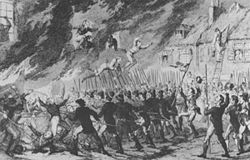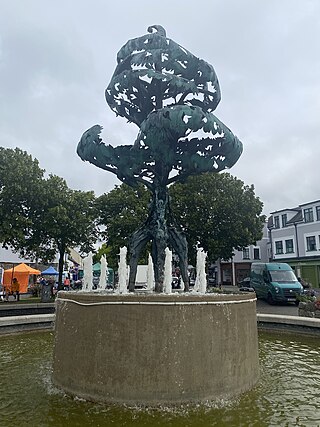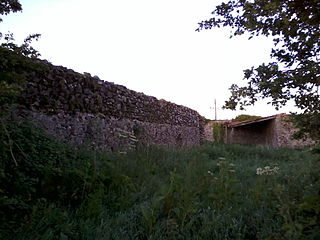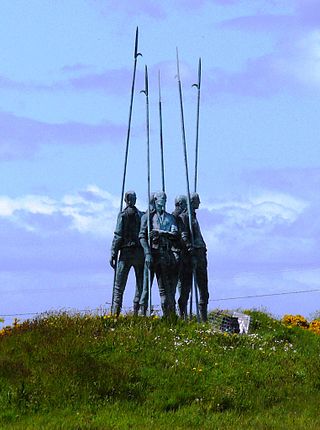This article needs additional citations for verification .(July 2016) |

Croppy was a nickname given to United Irishmen rebels during the Irish Rebellion of 1798 against British rule in Ireland.
This article needs additional citations for verification .(July 2016) |

Croppy was a nickname given to United Irishmen rebels during the Irish Rebellion of 1798 against British rule in Ireland.
The nickname "Croppy" was used in 18th-century Ireland in reference to the cropped hair worn by Irish nationalists who were opposed to the wearing of powdered periwigs closely associated with members of the Protestant Ascendancy. They were inspired by the sans-culottes of the French Revolution, who also forewent the wearing of periwigs and other symbols associated with the aristocracy. During the Irish Rebellion of 1798 against British rule in Ireland, many United Irishmen rebels wore cropped hair, which led the Dublin Castle administration and government forces (in particular the militia and yeomanry) to frequently arrest anyone wearing the hairstyle as a suspected rebel. A form of torture known as pitchcapping was specifically invented to use on "croppies", who retaliated by cropping the hair of Irish unionists to reduce the reliability of this method of identifying their sympathisers. [1]

Seamus Justin Heaney was an Irish poet, playwright and translator. He received the 1995 Nobel Prize in Literature. Among his best-known works is Death of a Naturalist (1966), his first major published volume. Heaney was and is still recognised as one of the principal contributors to poetry in Ireland during his lifetime. American poet Robert Lowell described him as "the most important Irish poet since Yeats", and many others, including the academic John Sutherland, have said that he was "the greatest poet of our age". Robert Pinsky has stated that "with his wonderful gift of eye and ear Heaney has the gift of the story-teller." Upon his death in 2013, The Independent described him as "probably the best-known poet in the world".
"Croppies Lie Down" is an Irish folk song, dating from the 1798 rebellion in Ireland, that celebrates the defeat of the Irish rebels. The author has been reported as George Watson-Taylor.

The Irish Rebellion of 1798 was a major uprising against British rule in Ireland. The main organising force was the Society of United Irishmen, a republican revolutionary group influenced by the ideas of the American and French revolutions: originally formed by Presbyterian radicals angry at being shut out of power by the Anglican establishment, they were joined by many from the majority Catholic population.

The Battle of Prosperous was a military engagement between British Crown forces and United Irishmen rebels during the Irish Rebellion of 1798 in the town of Prosperous, County Kildare. Prosperous was founded by Sir Robert Brooke in 1780 as a village for processing cotton produced in the Americas. When a rebellion spearheaded by the United Irishmen broke out against British rule in Ireland, rebel forces led by John Esmonde made plans to capture Prosperous. Esmonde had 200 rebels under his command, while Prosperous was garrisoned by elements of the Royal Cork City Militia under the command of Captain Richard Swayne reinforced by detachments of a Welsh mounted fencible regiment, the Ancient British Regiment of Fencible Cavalry Dragoons, numbering 150 men in all.

The Battle of Vinegar Hill was a military engagement during the Irish Rebellion of 1798 on 21 June 1798 between a force of approximately 13,000 government troops under the command of Gerard Lake and 16,000 United Irishmen rebels led by Anthony Perry. The battle, a major rebel defeat, took place on 21 June 1798 on a large rebel camp on Vinegar Hill and in the streets of Enniscorthy, County Wexford where the Rebels took 11 minutes to get down from the hill led by Peggy the Black, and marked the last major attempt by the rebels to resist government forces in a pitched battle.

The Battle of Carlow took place in Carlow town, Ireland on 25 May 1798 when Carlow rebels rose in support of the 1798 rebellion which had begun the day before in County Kildare. The United Irishmen organisation in Carlow led by a young brogue-maker named Mick Heydon who had taken over the leadership following the arrest of the previous leader, Peter Ivers, who was arrested with several other leading United Irishmen at Oliver Bond's house in March of that year, had assembled on the night of the 24th and set off at dawn to attack the county town. Picking up more volunteers along the way, their numbers swelled to around 1,200 they marched completely unopposed.
The Carnew executions refer to the summary execution of 28 prisoners being held as suspected United Irishmen by yeomanry troops from the Carnew garrison stationed in the barracks of Carnew Castle, County Wicklow, Ireland on 25 May 1798.

Pitchcapping is a form of torture which involves pouring hot pitch or tar into a conical paper cap and forcing it onto an individual's head, which is then allowed to cool before being rapidly removed. Typically, victims of pitchcapping suffer loss of skin and tissue around their head. The practise of pitchcapping dates back to the period of classical antiquity, but was used most prominently during the suppression of the Irish Rebellion of 1798. Pitchcapping was usually preceded by the hasty shaving of the victim's hair, and the effect it had resembled scalping in the injuries inflicted. In other forms of pitchcapping, pitch or tar was poured into the victim's orifices instead, though since doing so invariably proved fatal, this was more akin to a form of execution instead. Another form of pitchcapping involved smearing cloth or a piece of paper with pitch and pressing it onto the head of the victim.
John Kelly lived in the town of Killanne in the parish of Rathnure, west of Enniscorthy, in County Wexford in Ireland, and was a United Irish leader who fought in the Irish Rebellion of 1798. Kelly was obviously well known to rebels and loyalists alike during the short duration of the Wexford Rebellion but almost nothing is known of him outside this time. He was one of the leaders of the rebel victory at the Battle of Three Rocks which led to the capture of Wexford town but was later seriously wounded while leading a rebel column at the Battle of New Ross.
"The Wearing of the Green" is an Irish street ballad lamenting the repression of supporters of the Irish Rebellion of 1798. It is to an old Irish air, and many versions of the lyric exist, the best-known being by Dion Boucicault. The song proclaims that "they are hanging men and women for the wearing of the green".

Geneva Barracks in County Waterford, Ireland, was a barracks created in 1783 by converting a settlement which had been created for an 18th-century colony of disaffected citizens of Geneva following the Geneva Revolution of 1782. Built near Passage East, the colony was commissioned by the Irish Parliament and approved by the Crown. After the Genevans abandoned their plans to settle in Waterford, the colony became a military barracks instead. During the Irish Rebellion of 1798, the barracks was transformed into a holding centre for captured United Irishmen rebels, many of whom were executed, transported or conscripted. Today, the only remains of New Geneva are its ruined walls in a grassy field.

"The Rising of the Moon" is an Irish ballad recounting a battle between the United Irishmen, led by Theobald Wolfe Tone, against British forces during the Irish Rebellion of 1798.

John Murphy was an Irish Roman Catholic priest of the Roman Catholic Diocese of Ferns, who is mainly remembered for his central role in the Irish Rebellion of 1798 in County Wexford, which is sometimes known as the Wexford Rebellion. He led the rebels to one of their initial victories over a government militia at Oulart Hill, and in the following weeks became one of the rebellion's main leaders.
Events from the year 1798 in Ireland.

Bartholomew Teeling was an Irish military officer and nationalist who was leader of the rebel forces during the Irish Rebellion of 1798 and who carried out an act of bravery during the Battle of Collooney. He was captured at the Battle of Ballinamuck and subsequently executed for treason.

The Wexford Rebellion refers to the outbreak in County Wexford, Ireland in May 1798 of the Society of United Irishmen's rebellion against the British rule. It was the most successful and most destructive of all the uprisings that occurred throughout Ireland during the 1798 Rising, lasting from 27 May 1798 until about 21 June 1798. The Wexford Rebellion saw much success despite County Wexford not being thought of as an immediate threat by the government, because of the spontaneous risings that occurred both before and after the significant rebel victories in Oulart, Enniscorthy, and Wexford town.

1798 – The First Year of Liberty is an album of traditional Irish songs relating to the 1798 rebellion by the United Irishmen. All songs are sung by Frank Harte and some are accompanied on bouzouki, guitar and occasional bodhrán by Donal Lunny.
William B. McBurney was an Irish poet who used the pseudonym Carroll Malone. He was the author of The Croppy Boy, a poem commemorating the Irish Rebellion of 1798, and “The Good Ship Castle Down” . He immigrated to the United States, where he continued to write poetry in Boston, Massachusetts. He died in 1892.

The Battle of the Big Cross was a military engagement of the Irish Rebellion of 1798 between a force of United Irishmen rebels and a column of government troops. It was fought on 19 June 1798 on a spot on the Shannonvale-Ballinascarty road known locally as the "Big Cross", approximately four miles east of Clonakilty in West Cork. It was the only battle fought in the rebellion in County Cork.

The Croppies' Acre, officially the Croppies Acre Memorial Park, is a public park in Dublin, Ireland. It contains a memorial to the dead of the 1798 Rebellion.
